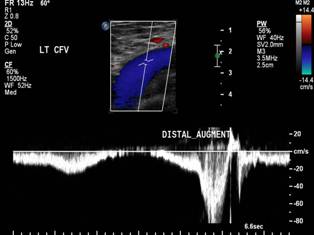Deep vein thrombosis (venous duplex)
Thrombosis or clot formation in the deep veins of the lower limb can lead to discomfort and swelling of the limb. Deep vein thrombosis (DVT) can be a cause of long-term leg swelling and other symptoms, and it can be serious in the short-term. If the blood-clot breaks loose and travels through the venous system (an embolism) to the lung, it will lodge in the pulmonary artery, causing a potentially fatal pulmonary embolism.
A number of factors can contribute to risk of DVT. These include prior DVT or clotting disorders; trauma; recent major surgery; medical problems, including cancer and blood diseases; immobilization; obesity and others.
 Duplex showing deep vein thrombosis
Duplex showing deep vein thrombosis
Evaluation of the lower-extremity veins is indicated if there is a clinical suspicion of acute DVT. Screening blood tests (D-dimer assay) and established clinical predictors may help to determine the need for a Vascular Laboratory evaluation. A venous study by the Vascular Laboratory may be requested to evaluate outpatients, but most DVTs are detected in hospitalized patients. Tests to evaluate for DVT can be done in the Vascular Laboratory or a portable ultrasound system can be used to perform the test at the bedside.
No special preparation is required. A complete study usually takes about 30 minutes.
Treatment is usually needed if a DVT is found. In most cases, this involves anticoagulation treatment with blood thinners. This therapy can be started immediately for hospitalized patients and outpatients may be sent to the UC Davis Medical Center Anticoagulation Clinic. The duration of therapy may vary.
In some cases, only small thrombi (clots) are found in the calf veins. Anticoagulation therapy may be appropriate for some. For others, observation may be recommended, with serial duplex scans in the Vascular Laboratory.
Evaluation by a specialist in the Division of Vascular Surgery may be recommended. If a DVT is found and anticoagulation therapy cannot be used, a minimally invasive procedure to place an inferior vena cava (IVC) filter may be performed to provide protection from a potentially fatal pulmonary embolism. Some IVC filters have the option to be removed later, if no longer needed. Also, for some patients with large DVTs, clot-dissolving therapy, or thrombolysis, may be considered. Catheter-directed venous thrombolysis may reduce the risk of developing chronic venous insufficiency.
See also:
Diseases, conditions and their treatments: Deep vein thrombosis
